The textile printing of the color-changing function can also be called the textile shadow printing, which is to make the color of the pattern on the textile change with the ambient temperature, the change of the light and the light, the change of the wet and dry of the fabric, etc., and the color of the pattern is also caused. The change function that disappears with it. That is to say, the pattern color on the fabric changes from the conventional "static" to the novel "dynamic", and the change in color is generally reversible. The textile printing technology of color changing function is to print modern high-tech materials on textiles. This color-changing textile can be made into summer clothes, towels, costumes, overalls, beach pants, swimwear, children's clothes, T-shirts, umbrellas, ponchos, Curtains, etc. When people are wearing or using, they feel the unpredictable fun and achieve strange dynamic effects.
The textile printing of color changing function currently has thermal color changing function printing (warm color printing), photosensitive color changing function printing (photochromic printing), floating water çœ functional printing and water color changing function white printing.
Thermal color printing
Thermal color-changing function printing (warm color printing) is a typical representative of the shadow printing. The color of the fabric printed by the thermo-sensitive color-changing function changes simultaneously with the change of temperature, and the substance discolored according to temperature can be divided. For the inorganic and organic categories, most of the thermochromic substances used in textiles use organic color-changing substances.
1, the principle of thermal color change
The thermochromic printing on textiles is currently using a thermochromic coating, that is, after processing the thermochromic organic dye into microcapsules, it is printed on the fabric by a paint printing process. Thermochromic organic dyes are reversible and irreversible, and are generally reversible for textiles. The thermochromic organic dye is composed of three parts: a leuco dye, a color developer and a desiccant (a desensitizer). The leuco dye is a substance that combines protons to develop color, like a lactone compound, in a color changing system. In the middle as an electronic part. The developer is an acid-releasing compound that reversibly releases protons, that is, an electron-withdrawing compound. For example, the leuco dye is crystal violet lactone, and the color developer is a discoloration system of bisphenol A. In a certain medium, when the temperature drops to a certain temperature, bisphenol A releases protons, that is, electrons are obtained, and crystal violet lactone is opened. The ring, the molecular rearrangement, the conjugated double bond through and the bisphenol A ion combine to present a color. The color developed varies with the substituents R and X, see Table 38-1. When the temperature rises to a certain value, the bisphenol A of the color developer binds to the proton, and the crystal violet of the leuco dye becomes a lactone structure, that is, a closed loop. Separate from the bisphenol A, the color disappears and is colorless. The color change system of leuco dyes and color developers must be in a special solvent to achieve the color change effect. The melt of this solvent has good solubility for leuco dyes and color developers, and can enhance the heat of the system. Sensitive, so called sensitizer (suppressant).
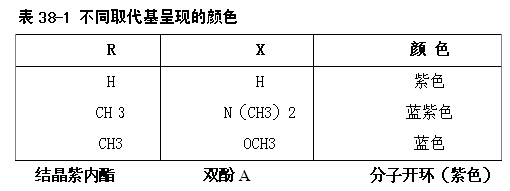
The sensitizer is generally a meltable higher fatty alcohol, a fatty acid and an ester thereof, an aromatic hydrocarbon, and an ether and ester compound thereof, which directly determines the color change temperature. Table 38-2 below shows crystal violet lactone as a leuco dye, and bisphenol A as a color developing agent, which uses different higher aliphatic alcohols and amides as solvents, and different discoloration temperatures.
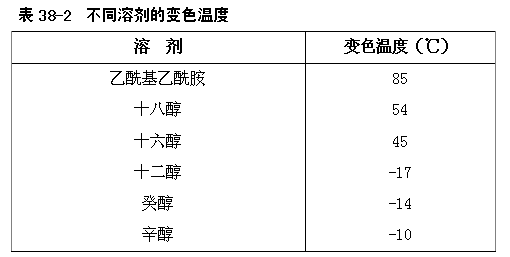
Usually, a variety of solvents can be used to lower the discoloration temperature, and a polymer compound such as polyvinyl alcohol can be added to improve the discoloration sensitivity and thermal stability.
2. Composition of thermochromic organic dyes
The thermochromic organic dye is composed of three parts: a leuco dye and a coloring agent drying agent (sensitizer). The chemical composition and action are shown in Table 38-3:

The color change of thermochromic organic dyes is reversible, and the color change process is shown in Figure 38-1:
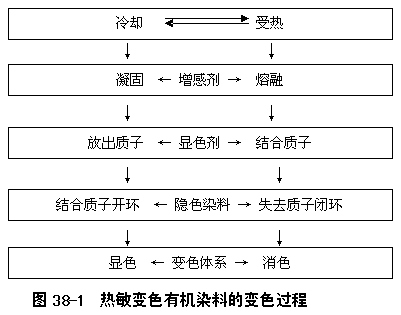
3. Prescription and process of thermal color changing function printing
Process flow: The printing of thermochromic paint on textiles mainly adopts microencapsulation technology. Therefore, the process of printing flowers is basically the same as that of ordinary paint printing process. The process is: printing (100 mesh) → drying (100 °C)→baking (150°C, 3min)→finishing→finished product.
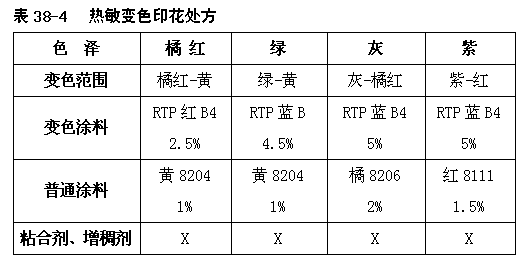
Second, photosensitive color-changing function printing
Photochromic function printing (photochromic printing) can be divided into two types: reversible and irreversible. Because the fabric is printed after ultraviolet light, it is also called ultraviolet light color printing. When the fabric leaves the ultraviolet light, it returns to colorless. It’s coming back in time, and the changes are endless. This kind of photosensitive functional printing fabric not only enjoys the unpredictable fun, but also the depth of the color of the fabric after ultraviolet light irradiation. Knowing the intensity of ultraviolet light, it can take preventive and protective measures against the skin.
1, the principle of photosensitive color
The principle of photochromism is mainly caused by the change of molecular structure caused by the absorption of light by the dye molecules, which is a photoisomer.
2, photochromic functional dye composition
At present, the dyes of photochromic function are mainly composed of heterocyclic molecular structures. The dyes of such heterocyclic molecular structures can undergo reversible changes after ultraviolet light. When the molecules are closed, the dye A is colorless. After ultraviolet light irradiation, the molecules are opened. The dye B, which becomes a cyanine structure, is blue, and the dye B re-transforms into a colorless dye A after leaving the ultraviolet light.
The reason for the discoloration of ultraviolet light is that the bonds in the molecular structure of the dye undergo ring opening and ring closure. The photochromic dye is also made into a microcapsule like a thermochromic dye, and then printed by a paint printing process.
3. Prescription and process flow of photosensitive color printing
The photochromic printing process is basically similar to the paint printing process: printing (100 mesh) - drying (100 ° C) - low temperature baking (120 ° C, 5 points).
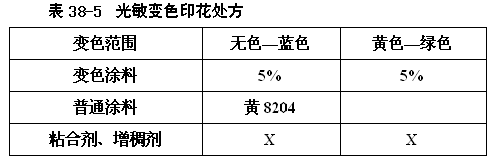
Naips LED Emergency Down Light is specially designed for ceiling recessed emergency lighting. Automatically light at once when buildings main power outage. NON-MAINTAINED type and it can customized the emergency time for different wattage. We can also add the LED emergency driver kits to match different kinds of your LED downlights.
Led Downlight With Emergency Backup,Downlight With Emergency Backup,Emergency Light Downlight,Led Emergency Downlight
Foshan Nai An Lighting Electric Co.,ltd , https://www.naipslighting.com